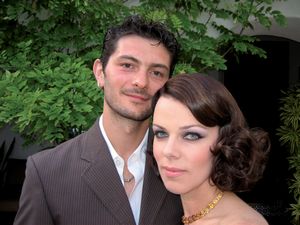Surf the TV channels in Italy, and you are bound to come across the current most popular show, for it is broadcast seven days a week. Or, if you look at TV listings and see the show’s name, Amici, you might think, as I first did, ‘Oh how greatit’s Friends, dubbed’.
Even if you watch an episode and realize it is a contest, you won’t be within a mile, or even a kilometer, from truly understanding this Italian phenomenon.
For that, you have to see it in person.
In February, I traveled to Rome and backwards in time when I walked through the gates of the legendary Cinecittà complex, the studio where the Italian greats made their cinema masterpieces and Amici is shot.
But first I had to get by the gargoyles. Unlike its current Hollywood counterparts, with their distinct vision for tomorrow, Cinecittà seems frozen in the 1960s. Reminded of scenes from La Dolce Vita, I had the eerie of finding myself inside a Fellini film. I was immediately approached by a woman, who if I had met her anywhere else, I would have described her as being ‘right out of a Fellini movie.’ She was ageless (anywhere between 60 to 100), a bit grotesque, a bit scary. She told us that she was an actress, and that we should take her back to Hollywood with us. I later learned that in fact she had been in every Fellini film and was always there, like an accident of the celluloid that had peeled off the screen.
From the gargoyles to the gladiators as I stepped into the ‘Colosseum’ of the Amici set. Yelling, stamping feet, flashing neon lights, and loud music filled the ‘arena’.
Amici is similar to American Idol: a talent contest that results in a professional contract. Auditions draw thousands of teenaged hopefuls (the most highly rated national TV show, it is in its sixth season). The 24 finalists, divided into two opposing teams, come to Cinecittà, where they live and attend ‘school’ every day: four to six hours of classes in singing, acting and dancing. The teams are kept separate. They see each other only during the competitions on Saturday and Sunday evenings.
On these evenings, Maria De Filippi, who is the producer and overall ‘boss’ of the program, as well as one of the most powerful women in Italian television today, is the host of the show. She announces the different competitions and contestants. Turning her back to the audience, she seems to allow fate—in the guise of a large, flashing machine—to select the contestants and events. The teens sing, dance, or emote, as assigned.
When the performance is over, the real competition begins. First the judges comment on the performance. They are, apparently, experts in each talent: a middle-aged, over-the-top transvestite drag queen; an over-the-hill professional ballerina; and several other instructors in dance, theatre and singing.
The viciousness of the judges’ comments makes Simon Cowell of American Idol seem encouraging and protective. The ex-prima ballerina told one of her students, a girl she herself was teaching two to four hours every day, that she was not a good dancer, adding ‘don’t feel bad, not everyone is cut out to dance’.
Once blood is drawn, the frenzy begins. After her damning critique of her student, the ballet maestra is accused by the singing teacher of being jealous and bitter because she is no longer a star, and of using the show for self-promotion.
This ‘friendly banter’ incites the spectators. They boo, stamp, and scream until the real ‘meal’ comes. Now the contestants critique each other.
First, a video shot during the previous week reveals teammates talking behind each other’s backs. Then, as the camera captures their live reactions, the contestants must describe how they feel about the vicious comments from their ‘friends’.
At this point, Maria calls in the lions, encouraging more attacks and counterattacks. The nastier it gets, the more revved up the audience becomes, thus making for ‘great TV’ and of course feeding the most important monster of all, the ratings.
Coming from the nation that brings the world reality shows like Big Brother, Fantasy Island, and Fear Factor, who am I to criticize such a successful phenomenon? Yet the difference I see is that Amici both exploits youth and rewards them for excelling in behavior that all cultures find despicable. In American Idol, the judges may say cruel things to the contestants, but the judges are not the contestants’ teachers. And although I’m sure there is gossip and backstabbing behind the scenes of American Idol, it is never rewarded or instigated to make the show ‘juicier’ for spectators.
While watching the Amici show live, I realized that the ‘talent’ that is given the most attention, the most screen time, and loudest applause from the crowd is not the skill or beauty of the performers, but how well they hone the art of cruelty.






